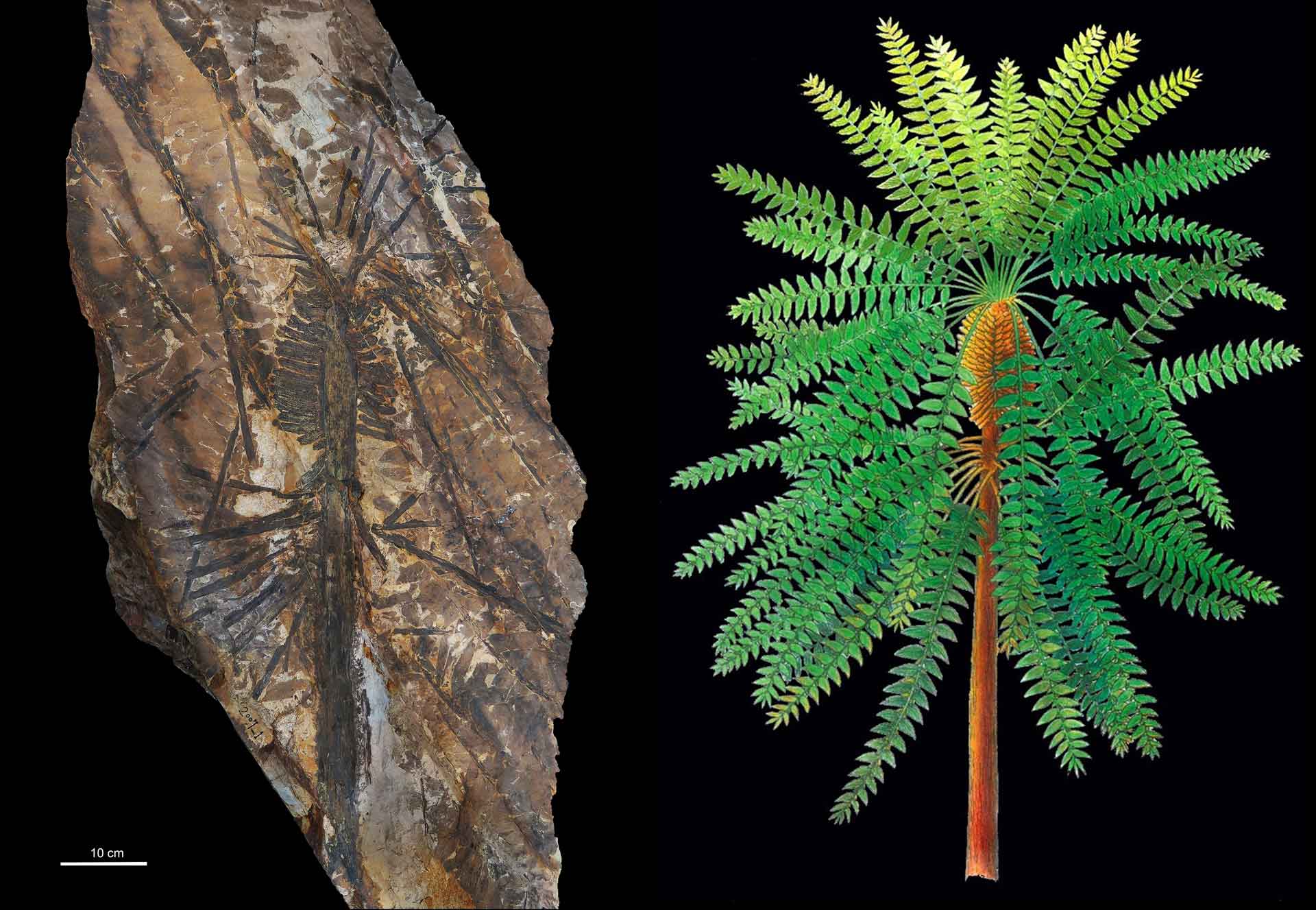
A number of trunks and tree crowns preserved in place.
Geological Period
Permian (Cisuralian)
Main geological interest
Paleontology
Stratigraphy and sedimentology
Location
Wuda Coalfield, Wuhai City, Inner Mongolia, China
39°32’03”N, 106°37’36”E
A number of trunks and tree crowns preserved in place.
A coal-forming tropical rainforest preserved in exceptional detail by volcanic ash.
The Wuda Fossil Site yields the largest number of reconstructed fossil plants and the largest precisely (by quadrat sampling method) reconstructed actual landscape of a coal-forming vegetation globally, offering a unique window to understand past floral community ecology. More than fifty taxa illustrate the high diversity and evolutionary status of the coal-forming forest. Some species are described as whole-plants (e.g., Wang et al., 2021), delivering scientific breakthroughs in plant systematics and in restoring live trees. The Wuda Fossil Site is exceptional for best demonstrating those plants that formed coal and what a coal-forming forest looked like.
- Geological description
The Wuda fossils represent an exceptional record of an ancient forest that has been termed the Permian “vegetational Pompeii” (Wang et al., 2012). The forest was peat-forming and buried in place by ashfall, now appearing as a tuff bed between two coal seams in the Wuda Coalfield, Inner Mongolia. The tuff is dated to 298.34 ± 0.09 Ma from the earliest Permian and lies approximately on the Carboniferous-Permian boundary (Schmitz et al., 2021). Plant remains are preserved as unusually complete plants showing gross form, but also are often partly permineralized preserving internal structure. Vegetation includes more than 50 species from seven groups, namely lycopsids, sphenopsids, filicalean ferns, progymnosperms, seed ferns, early conifers and cycads. Many lines of evidence record insect-plant interactions (e.g., feeding) and plant-plant interactions (e.g., climbing, Zhou et al., 2019), preserving intricate details of an ancient tropical rain forest community and interplay between different organisms.
This unique “Permian Coal Forest offers a glimpse of late Paleozoic ecology” (Bashforth and DiMichele, 2012) and has been headlined as “Primeval Land Rises from the Ashes: A ‘vegetational Pompeii’ buried in a coal deposit that is shedding light on ecosystem structure and climate during the Permian period” in SCIENCE by Hvistendahl (2012).
- Scientific research and tradition
Wuda Fossil Site was discovered in 1998 and recognized as a forest buried by ash in 2003. Subsequently an international research team of about 30 experts from England, the United States, the Czech Republic, Germany and China have published over 60 papers on its taxonomy, ecology and geology. Active research continues.
- Reference
Bashforth, A.R. and DiMichele, W.A. (2012) ‘Permian Coal Forest offers a glimpse of late Paleozoic ecology’, Proceedings of the National Academy of Sciences, 109(13), pp. 4717–4718. Available at: https://doi.org/10.1073/pnas.1203261109.
Hvistendahl, M. (2012) ‘Primeval Land Rises From the Ashes’, Science, 336, p. 662.
Schmitz, M.D. et al. (2021) ‘A volcanic tuff near the Carboniferous–Permian boundary, Taiyuan Formation, North China: Radioisotopic dating and global correlation’, Review of Palaeobotany and Palynology, 294, p. 104244. Available at: https://doi.org/10.1016/j.revpalbo.2020.104244.
Wang, J. et al. (2012) ‘Permian vegetational Pompeii from Inner Mongolia and its implications for landscape paleoecology and paleobiogeography of Cathaysia’, Proceedings of the National Academy of Sciences, 109(13), pp. 4927–4932. Available at: https://doi.org/10.1073/pnas.1115076109.
Wang, J. et al. (2021) ‘Ancient noeggerathialean reveals the seed plant sister group diversified alongside the primary seed plant radiation’, Proceedings of the National Academy of Sciences, 118(11), p. e2013442118. Available at: https://doi.org/10.1073/pnas.2013442118.
Zhou, W. et al. (2019) ‘A left-handed fern twiner in a Permian swamp forest’, Current biology: CB, 29(22), pp. R1172–R1173. Available at: https://doi.org/10.1016/j.cub.2019.10.005.
- Author(s)
Jun Wang.
Nanjing Institute of Geology and Palaeontology, Chinese Academy of Sciences.
Renbin Zhan.
Nanjing Institute of Geology and Palaeontology, Chinese Academy of Sciences.
Hermann W. Pfefferkorn.
University of Pennsylvania. USA.


